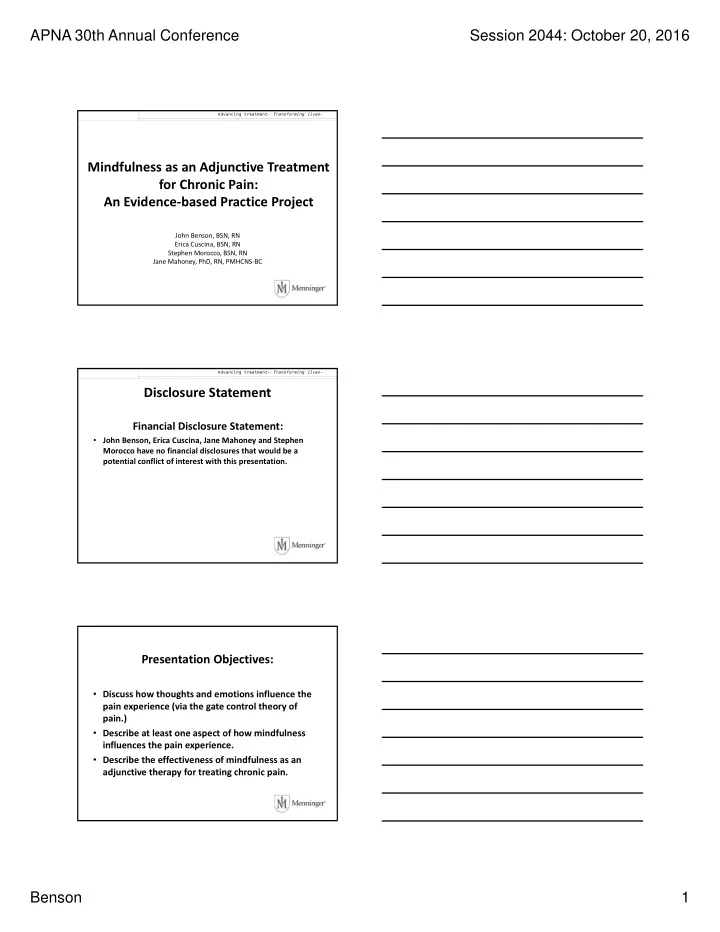

APNA 30th Annual Conference Session 2044: October 20, 2016 Advancing treatment. Transforming lives. Mindfulness as an Adjunctive Treatment for Chronic Pain: An Evidence ‐ based Practice Project John Benson, BSN, RN Erica Cuscina, BSN, RN Stephen Morocco, BSN, RN Jane Mahoney, PhD, RN, PMHCNS ‐ BC Advancing treatment. Transforming lives. Disclosure Statement Financial Disclosure Statement: • John Benson, Erica Cuscina, Jane Mahoney and Stephen Morocco have no financial disclosures that would be a potential conflict of interest with this presentation. Presentation Objectives: • Discuss how thoughts and emotions influence the pain experience (via the gate control theory of pain.) • Describe at least one aspect of how mindfulness influences the pain experience. • Describe the effectiveness of mindfulness as an adjunctive therapy for treating chronic pain. Benson 1
APNA 30th Annual Conference Session 2044: October 20, 2016 Advancing treatment. Transforming lives. Advancing treatment. Transforming lives. Advancing treatment. Transforming lives. Mindfulness • Mindfulness addresses the psychological aspects of pain. • Mindfulness = Awareness in the moment – Self regulation of attention to immediate experience. – A specific orientation to experience in the present moment (curiosity, openness, acceptance). Benson 2
APNA 30th Annual Conference Session 2044: October 20, 2016 Advancing treatment. Transforming lives. Advancing treatment. Transforming lives. PICO Questions Population, Intervention, Comparison, Outcome • Among patients with chronic pain, is mindfulness + standard of care superior to standard of care alone in reducing pain intensity? • Among patients with chronic pain, is mindfulness + standard of care superior to standard of care alone in improving quality of life? Gotlink et al., 2015 Level I Validity: Results: Systematic Review & Meta ‐ analysis Detailed description of the Mindfulness and Chronic Pain • search strategy. • Significant improvement: Aim: • Depressive symptoms Systematic overview of the • Extracted data based on • Pain burden effectiveness of MBSR and PRISMA guidelines for • Physical health MBCT in different patient systematic reviews. populations in order to • Significant decrease in: identify the patient • Standard mean difference • Pain intensity categories in which these combined for meta ‐ • Pain disability interventions are indicated. analysis. Compared with wait ‐ list control (but not with • Clear steps to reduce the health education) Studies related to chance of double counting mindfulness and chronic pain: any individual study. • In fibromyalgia, improved: • 3 systematic reviews met Quality of life • inclusion criteria • Steps taken to obtain • Depression • 13 unique missing data from study randomized control reports described. trials • 722 unique patients Benson 3
APNA 30th Annual Conference Session 2044: October 20, 2016 Lakhan & Schofield, 2013 Level I Validity: Results: Systematic Review & Meta ‐ Mindfulness and pain analysis • Search strategy detailed. • SMD = ‐ 0.21 , 95% • Valid psychometric measures. CI = ‐ 0.37, ‐ 0.03 • Most common and Aim: • Significantly in favor of the comparable outcomes To test the efficacy of experimental group measures from individual mindfulness ‐ based therapies ( p <0.05) studies assessed. In subgroup analysis: in treating somatization • • Used Cochrane and PRISMA disorders. Significance for the IBS Guidelines to ensure validity group only of the study ( p < 0.001) • Limited conclusions can be 13 randomized controlled drawn due to small number of Mindfulness & quality of life trials studies with small sample • SMD = 0.39, 95% sizes CI = 0.19, 0.59 • High level of heterogeneity • Significantly in favor of the (multiple conditions) experimental group ( p • However, expected given <0.001) the heterogeneity of • In subgroup analysis: somatization disorders Significance for the IBS and variability of MBT programs. group only ( p <0.001) . Esmer, et al., 2010 Level 2 Validity Results Randomized Control Trial Strengths Pain Acceptance & QOL • No statistical difference • 4 point increase (on an 18 Aim: between intervention and point scale) p <0.014 control group To evaluate short term • Subjects were randomized Physical Function efficacy of MBSR therapy for to intervention • 3 point decrease (on a 24 improving QOL in adults with • 12 and 40 week follow up point scale) p <0.005 failed back surgery Method: Threats Pain Intensity Prospective, randomized, • Chosen arbitrarily – • 5 point decrease (on a 30 single ‐ blind, parallel group indicating bias point scale) p <0.021 clinical trial • Reliability and validity of Feasibility study measures used was not Sleep Quality Sample: reported • 1 point decrease (on a 5 N = 25 patients with failed • Power analysis not point scale) p <0.047 back surgery syndrome (FBSS) performed a priori to Analgesic Medication Log determine sample size 1 point decrease (on a 4 (MBSR [N = 15]; TAU [N = 10]) • • No intent to treat point scale) p <0.001 Results • Mindfulness is likely to be a somewhat effective adjunctive therapy for patients with chronic pain. • Shown to potentially improve pain and quality of life . • There is indication that mindfulness may be useful and not harmful . • There is indication that mindfulness can decrease analgesic use . Benson 4
Recommend
More recommend